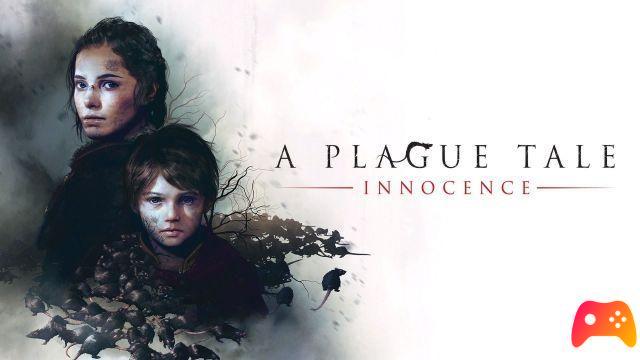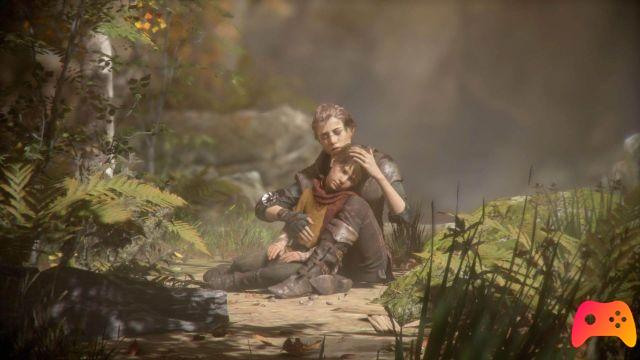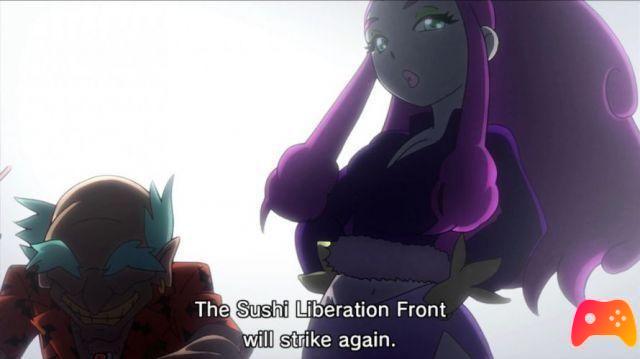
Review for A Plague Tale: Innocence. Game for PC, PlayStation 4 and Xbox One, the video game was released on 14/05/2019
Give it a try: having spotted a school of fish, throw a piece of bread into the water. You will see dozens, hundreds of large and small fish pounce on the piece of bread, attack it, if you like, with an almost ancestral fury. Over time you will see the piece of bread wear out and get smaller and smaller until it disappears completely. There is nothing wrong with that, of course: it's a piece of bread and they're just harmless fish amid the laughter of children. But if the fish had sharp teeth and it wasn't the bread that was consumed, but one person… it wouldn't be fun anymore.
Animals, as we know, do not know malice like humans do and follow their own survival instinct. In the carnivorous kingdom, the word "survival" implies the death of another specimen, willingly or unwillingly sacrificed to the persistence of another. It's the nature. It is the circle of life. How unfair nature can sometimes be. And how unfair history can sometimes be.
The pages of the history books, in fact, are written in blood. In addition to man, who has always been a protagonist, the palm of the greatest murderer in history goes to diseases. “Nobody loves disease,” Mater Morbi told Dylan Dog. It's damn true: we can say that until the 900s, a time of revolutionary discoveries in the medical field, there were no effective drugs, but uncertain decoctions, and the hygienic conditions were poor. People fell at a young age, punctual as autumn leaves. All of this is A Plague Tale: Innocence, the promise of Asobo Studio, which personifies the disease by shaking together more than 5.000 plague-carrying rats.
It is very sobering to experience the hard life of the 1300s in A Plague Tale: Innocence sitting comfortably in 2019. During E3 2017, where the game was officially presented, its inconceivable rawness and the fraternal that ensued sparked the interest of many gamers. The game would take place in France during the Hundred Years War between the wave of the Black Plague that swept the country and the Holy Inquisition that moved among the piles of corpses, many of them caused by the Catholic Church.
Two years later Asobo Studio (French developer house) thanks to Focus Home Interactive brings a game very different than the typical production of the studio, made up of many more or less serious Disney / Pixar games, respecting that summer promise and bringing to PlayStation 4, Xbox One and PC the most interesting game of this videogame May.
In A Plague Tale: Innocence they control two brothers, Amicia and Hugo De Rune, with which he is destined to become attached. From a noble family, their existence is destined to soon become daring, fleeing fromInquisition that stops at nothing to capture Hugo, a sweet five-year-old boy who never left his room for health reasons. Amicia, the young and enterprising protagonist, is as if she had never met her little brother, kept away from the world by his mother, who is seeing the French countryside for the first time. Holding him by the hand seems strange, but that tightening gradually becomes more and more firm and comforting until it becomes fundamental. A Plague Tale: Innocence is a growth game and also a crescendo game, in which curiosity becomes attention after a few game chapters.
A small caveat to make is that our gaming experience was as virgin as possible from trailers and specials in which Asobo Studio invested their energies with unwavering faith in their project (which will be a pleasure to see later). Being a game strongly based on narration, following history without knowing what to expect is, to date, to be considered a privilege. A production very similar to a triple A game - even if it is not -, the so-called “gamer presentiment” experienced which places great hopes in a title without necessarily being overwhelmed by advertising has been satisfied on several occasions.
It is difficult, in fact, not to be enchanted by the game world, by the many details present on screen in A Plague Tale: Innocence and also smile at awkward nonsense like the soldier wiping the sweat from his forehead… from his helmet. Everything in the title tells us of a general withering of the country, plagiarized by not one, not two, but three threats: the Inquisition, whose knights invested with a sacred mission by the Grand Inquisitor were instructed to recover Hugo De Rune at any cost. (without having problems killing Amicia in brutal ways) and Rats, with a capital "r" due to their omnipresence, a wave that devours human flesh in a few seconds as if they were pieces of bread, in fact, and bring with them the Bite, a deadly disease that is none other than the black plague arrived (they say) overseas.
In the background, the English army, strangers singers of the Marsellaise, who clash with the Kingdom of France in a conflict that lasts more than a hundred years (1337-1453).
The aim of the young bourgeois Amicia and Hugo, therefore, is pure survival. Take on the role of the big sister and protect Hugo at all costs, really get to know him for the first time, it is a responsibility that we (gladly) feel the weight of, because it is difficult not to support for Amicia's ardor and Hugo's innocence, and to protect a helpless and sickly child.
Innocence is also the key word of the game, present in the game title and also throughout the chapters that divide it. Asobo Studio shows how difficult it is to keep innocence in a place of death, of how we would have liked to cover little Hugo's eyes over and over again. The French studio has opted for a very hard shock therapy: many scenes are permeated by an emotional and visual impact, and the rawness and cruelty of the game does not spare two creatures raised in ignorance (or innocence?) Like Amicia and Hugo.
Bloodless bodies, mass graves, skeletons, animal carcasses and blood: the forests and cities across the Alps are dotted with death and increasingly traumatizing scenes - the so-called it was dark in all its glory. We did not expect this level of "reality", terrible in its bluntness. A Plague Tale: Innocence gives us a choice, whether or not to be part of this carnage. It is no coincidence that one of the titles that most inspired this video game was The Last of Us, a game that squeezed the technical and narrative potential of the PlayStation 3 that also put our morality into play.
Amicia, like Ellie, is a simple girl forced to grow up fast: the only thing he will have in his hands to defend himself will be a slingshot with which it will be possible to distract and hit human enemies, showing how even a sling can be lethal. Amicia handles it with skill and it can be enhanced in various stations through materials scattered throughout the game world, such as sulfur, alcohol, leather and tools, the latter fundamental to enhance Amicia's sling or bag that allows her to store more materials or ammunition. Through the sling and a (rather quick) initiation intoalchemy, another important element in the title, Amicia will be able to launch alchemical projectiles to light fires from afar or put an enemy to sleep from near (Somnum).
La resource management is almost essential in some places: a single charge of Somnum, to give an example, will cost a lot and will most likely not allow us to upgrade the sling at the next station. Do I create the material or try to work around the problem and then create an upgrade? We have asked ourselves this question several times, although it must be said that in the France of A Plague Tale: Innocence there is no shortage of materials. At the same time, they are well balanced with the capacity of materials that Amicia can carry with her.
For this the game focuses heavily on stealth, about throwing rocks or pots to lure the guards elsewhere and sneak under their helmets. Despite this, if the enemies are alerted and Amicia is discovered and approached it will be almost impossible to defend herself and in the most common case she will be violently killed. Another component that seemed primary but which turned out to be absolutely not is not leaving Hugo alone, but holding him by the hand.. If left behind, Hugo will start to worry, scream and get noticed by the guards for a game over quote. In reality there is never any real need to leave Hugo alone and go ahead without him: everything Amicia can do without Hugo can also do it with: we never found ourselves in the course of the adventure having to leave him somewhere, but only to want to do it out of curiosity. The result is that nothing changes, except that you can't go too far in the second case. This mechanic - which if it had been preponderant would have been perceived as heavy, we realize - is never encouraged in the game, and it's a shame because from the premises it seemed to have more weight and perhaps they could have dared more on this front.
Another thing you have to come to terms with isexploration, present but limited. Checkpoints aren't always happy, and it's often not possible to go back, even when it would have been possible without any problems. It was one of the initial headaches of our test before getting into the "spirit" of the game and understanding that it prefers storytelling, and exploration is a side component (certainly encouraged) that improves as the various chapters progress: in the maps are in fact scattered objects of historical curiosity, gifts and Hugo's herbarium, composed of flowers that the child will often gently put in the hair of his older sister for aesthetic purposes only.
These objects, hidden and often expensive in resources to recover, greatly enrich the game world and prove, together with many other small minutiae, how Asobo Studio has kept us in the insertion of historical data to give credibility and foundation to France of around 1340.
Although he always remains faithful to his skeleton, the chapters of A Plague Tale: Innocence (which added together show a good overall duration) try to renew themselves every time, with small changes and additions: Amicia will be able to count on more bullets in her arsenal and soon friends, such as Lucas, a budding alchemist, or Mélie, a thief with a forked tongue, creating a group of survivors who will alternate with the succession of chapters and who will espouse the cause of the young woman of the De Rune family stating A Plague Tale as a choral game, made up of various motives but with a single purpose, to find a cure for Hugo and not to allow the Inquisition to exploit him for their sinister purposes.
This does not mean that Amicia will not end up finding herself alone and we can only count on anyone else but ourselves, mixing stealth sessions, puzzles and more excited phases with a runaway plot that thickens more and more a variegation desired and sought after by Asobo Studio.
Like our heroes, the antagonists will evolve hand in hand. THE rats, which are for sure themost distinctive element of the title, make up such a massive horde that one would expect at least one frame drop, and instead A Plague Tale: Innocence runs smoothly from start to finish. Closely linked with the young De Rune but relentless, they will be themost diabolical obstacle and at the same time the greatest allies to use against enemy knights. Their only weakness, strong (invincible) in their numbers is fire and looking around there will always be a way to avoid them - at least for a moment. If confronted without the aid of light, the rats will not skimp on hideously devouring anyone who comes within range, be it Amicia, Hugo and their companions, or the guards if we were to destroy their light source with a well-placed slingshot.
The game features the Spanish language (text and subtitles) with English, French and German dubbing. The English dubbing is well made and above all characterized by non-native speaker accents but with light French influences. Regarding the location no blunder to report apart from the expression "get out of the sling" in the enhancement menu, now more intentional and ironic but certainly not correct (since going out is an intransitive verb).
Without a doubt, A Plague Tale: Innocence manages to perfectly restore the sense of horror towards the atrocities of the so-called Holy Inquisition and the bitterness caused by the many strong scenes and by the many blows to the heart caused by the disease, which is expressed in an unnatural contamination of the protagonists' innocence. We believe, however, that the message of the French studio, making us find almost frozen flowers, intact in the decadent space of 300th century France, is that, in the end, the flowers that bloom in adversity are truly the rarest and most precious of all.

A historic advertisement from the 60s said "the first sip fascinates, the second witch". Skillfully juggling the Inquisition, Black Death and alchemy, A Plague Tale: Innocence is the work in which Asobo Studio has poured its heart. Probably the most stimulating title of this videogame May, following the stories of Amicia and Hugo De Rune is exciting, thanks to a narrative rooted in history but also fantastic in its final execution, in which we found all the inspirations revealed by the developers. Few flaws, like little Hugo's poor implementation in gameplay and exploration that could have been more daring. A multi-faceted game that leaves (deliberately?) Several questions pending, perhaps in view of a sequel that can only be encouraged, A Plague Tale: Innocence is but a premature grave of fireflies: you must always keep hope and swim against schools of fish (or rats) to protect those we love because bonds, after all, are all we have.
► A Plague Tale: Innocence is an Adventure-type game developed by Asobo Studio and published by Focus Home Interactive for PC, PlayStation 4 and Xbox One, the video game was released on 14/05/2019






